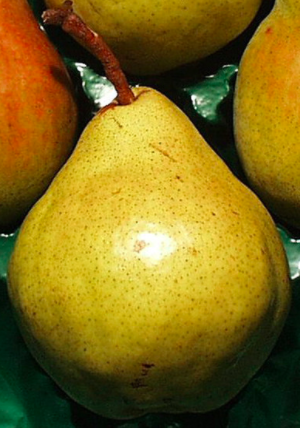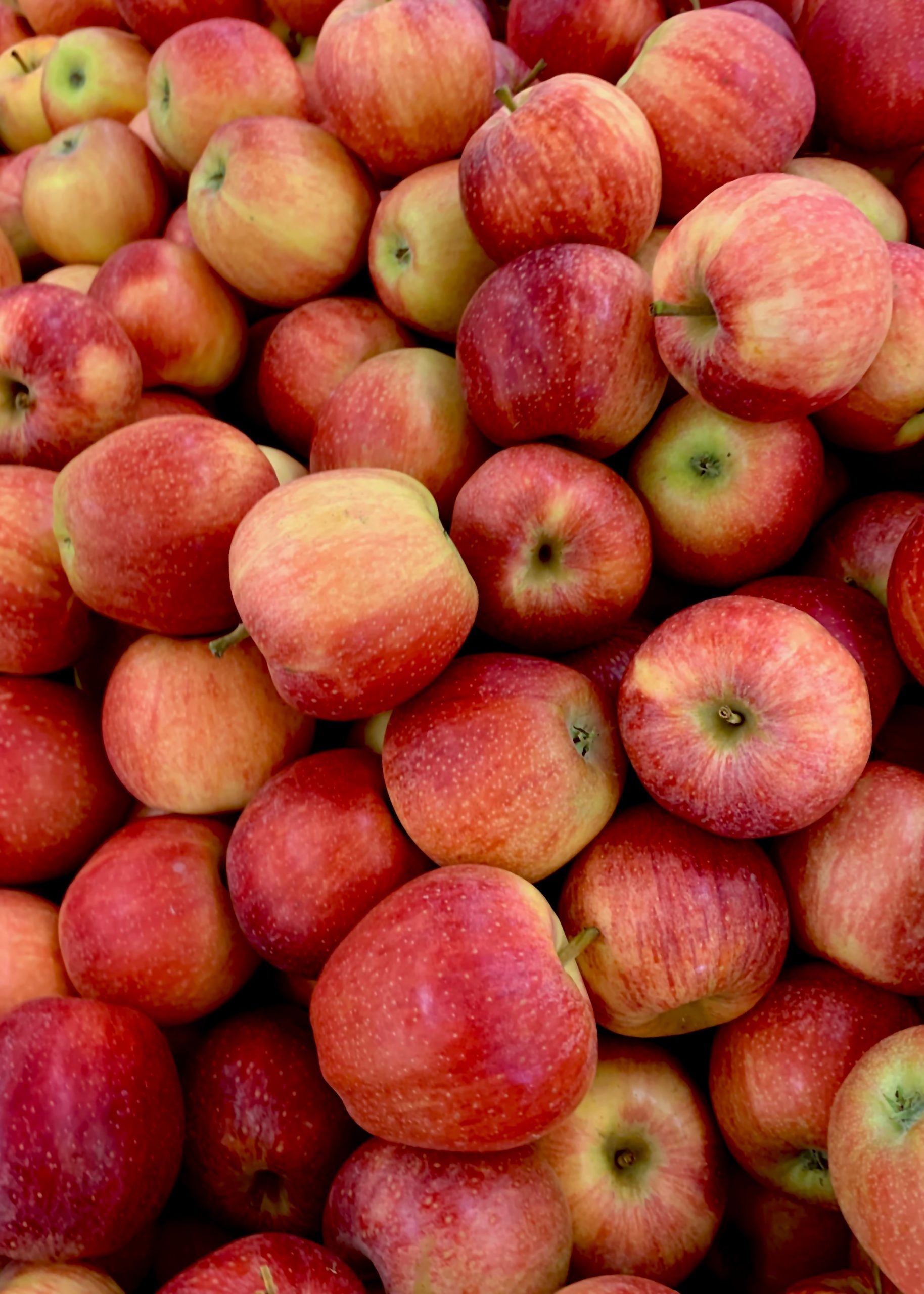Autumn Crisp

Introduced by Cornell University, this apple is a cross between Gold Delicious and Monroe varieties. Its flavor is described as having a unique sweet-tart taste.
This is a SPECIALTY variety that ripens in late October.
Fun Fact: It is noted for containing more Vitamin C than many other varieties.
Pro Tip: The flesh oxidizes slowly, so it doesn’t turn brown quickly; it is a great choice for salads or fruit trays.
Baldwin

This tart, firm, and bright red heirloom apple was for many years the most popular in New England, New York, and abroad.
This is a SPECIALTY variety that becomes available in late October.
Fun Fact: If kept in a cool storage space or root cellar, Baldwins can keep into the spring.
Pro Tip: Baldwins maintain their shape throughout the baking process so they are fantastic for baking pies and dumplings.
Black Oxford

The dark purple Black Oxford hails from Paris, Maine. It was found as a seedling by Nathaniel Haskell in the 1790s.
This SPECIALTY variety is available in late October.
Fun Fact: This variety for is a favorite for still life painters and photographers, as it has a compelling shape and color.
Pro Tip: You might be surprised (and delighted) by their somewhat chewy texture and white-green flesh that blends tart and sweet.
Cortland

According to Emily, the sweetly tart Cortland is the most versatile apple on the orchard. Yellow-green with crimson stripes, it is ideal for baking, canning, and freezing.
This STANDARD variety is ripe in late September, or early October.
Fun Fact: Dating back to 1898, the Cortland derives from the McIntosh, valued for its flavor, and the Ben Davis, known for its hardiness.
Pro Tip: Bake wedges with caramelized onions and brie on a pizza!
Cox’s Orange Pippin

A large red-orange apple with creamy, pale yellow flesh, this apple is sweet like honey and aromatic with a sharp, refreshing taste.
This SPECIALTY variety is available in very limited quantities, in mid to late October.
Fun Fact: These originated in England in 1865.
Pro Tip: These only keep for one to two months, so eat them fresh or bring them to the kitchen to be used in juices, hard cider, or baking!
Crimson Crisp

Sweet, sharp, and extra crisp, the bright red Crimson Crisp lives up to its name!
This SPECIALTY variety is available in late October.
Fun Fact: The original seedling was derived in 1971. The fruit was recognized for its excellent scab resistance.
Pro Tip: Eat fresh!
Empire

A cross between McIntosh and Red Delicious, this New York apple has a substantial fan club at Hope Orchards.
This STANDARD variety is ripe in early to mid-October.
Fun Fact: The white flesh is slow to oxidize, so it is great for salads or fruit plates since it retains its color long after cutting.
Pro Tip: Combine with Macouns and Spartans to make a sweet sauce great for canning and freezing.
Ginger Gold

Wonderfully sweet with a lemony finish, Ginger Gold has a unique flavor and a committed local following. Hope Orchards produces a very small but coveted quantity.
The Ginger Gold ripens early in our season. It is available in mid-September, and is a STANDARD variety.
Fun Fact: The US Apple Association desribes the Ginger Gold as one of the fifteenmost popular apple cultivars in the United States.
Pro tip: Though Ginger Gold is a great addition to the season’s first apple pie, we prefer to eat them thinly sliced and paired with sharp cheddar cheese or on salads.
Golden Delicious

Forget any previous experiences you have had eating a Golden Delicious. Our “Golden Yummy” as the kids describe it, is juicy, crisp, with a pear-like flavor. These super sweet apples are very different than what you’ll find in the supermarket.
This STANDARD variety is ready for picking in late October.
Fun Fact: Golden Delicious are not closely related to Red Delicious.
Pro Tip: Golden Delicious bake very well and make a great applesauce, and are preferred by many as the best apple to store for winter months.
Golden Russet

These apples look lovely on the trees in late fall, contrasting with the other shades of yellow, orange, red, and green.
As a STANDARD variety, the Golden Russet is ready for picking in late October.
Fun Fact: Many people remember this apple from their childhood. They were often kept late into December for holiday baking, and are the preferred variety for making traditional kuchen.
Pro Tip: This is primarily a display or cider apple, but some enjoy the firm, hard flesh and distinctive rough golden brown skin as a snacking apple.
Gold Rush

Crisp, sweet, with long storage capability, GoldRush has Golden Delicious parentage, but with a sharper taste.
This SPECIALTY variety is a good storage apple, and becomes available in mid/late October.
Fun Fact: Gold Rush showcased for the first time at our Apple Variety Weekend in October 2017. It was well received as a tart, crisp, oh-so-autumn apple. We like it best sliced in thick wedges with a bit of cheddar cheese.
Pro Tip: When harvested, the Gold Rush is yellow-green in color. When stored for winter months, its color ripens into a golden yellow.
Harrow Sweet Pear

Yellow with moderate russeting, the creamy-white flesh of the Harrow Sweet Pear is juicy and sweet.
This pear is available in late October.
Fun Fact: This is a hardy highly resistant pear.
Pro-tip: It is related to the Bartlett pear, and was developed in Canada.
Honeycrisp

One of the most cold-hardy apples, Honeycrisp was developed in Minnesota in the 1960’s, to withstand chilly temperatures.
This SPECIALTY variety is available in late September, and into October.
Fun Fact: The Honeycrisp is sometimes trademarked as Honeycrunch.
Pro Tip: No need to bake these into a pie: these refreshing, sweet, sharp and crisp apples are tastiest right off the tree!
Hyslop Crabapple

The Hyslop crab apple is of unknown origin and has been around since the mid-1800s. With dark red skin and purple overtones, from a distance it can easily be mistaken for a plum.
This STANDARD variety is ripe from mid-September to early October.
Fun Fact: Affectionately called “Crabs,” the actual variety name is sometimes spelled Hislop.
Pro Tip: Hyslop’s tangy astringent flavor is perfect for jellies. It also makes a great spiced or pickled apples.
Macoun

One of the finest baking apples in New England, this extra sweet, juicy, and aromatic apple is Brien’s personal favorite. It is a cross between McIntosh and Arkansas Black.
The Macoun is a STANDARD variety, ripe for picking from early to mid-October.
Fun Fact: While we can’t quite agree as to how to pronounce “Macoun” — is it “mah-coon” or “mah-cow-an”? — We unanimously agree that these apples are one of our absolute favorites!
Pro Tip: Pair with extra sharp cheddar or bite into this snappy apple fresh off the tree! Makes a superb sauce and pie.
Magness Pear

This is a juicy sweet dessert pear with honeyed juice and aromatic, buttery flesh.
The Magness is ready for ripening in mid-October.
Fun Fact: The Magness Pear is named in honor of Dr. John R. Magness, director of the USDA’s apple and pear breeding program in the 1960s, when this pear was developed.
Pro Tip: Its parents are the Comile pear and Sechel pear. Not a bad pairing!
McIntosh

Canada’s national apple, the tangy-sweet McIntosh reaches its peak in late September. With white-flecked red and green skin and soft white flesh, this apple is one of our most popular varieties.
This late September apple is a STANDARD variety.
Fun Fact: Since John McIntosh developed the apple in the early 1800s, it has been used to clone hundreds of varieties in New England, Canada, and Eastern Europe but is rarely found elsewhere.
Pro Tip: An apple-of-all-trades, McIntosh is a superior eating apple and also makes delicious applesauce, cider, and pies.
Mutsu (Crispin)

Named after the Mutsu Province in Japan, this sweet and sharp green apple was introduced in 1948 as a cross between the Golden Delicious and the Indo apple varieties.
Mutsu is a SPECIALTY variety that is available in late October.
Fun Fact: It’s also known as Crispin.
Pro Tip: This apple is great for eating, juicing, and drying, and maintains its shape when cooked.
Northern Spy

On a good year, Northern Spy are gargantuan. They are striped with paint brush look of green and red. They have tart, white flesh that’s juicy, crisp, and mildly sweet.
Northern Spy is a STANDARD variety, picked in middle to late October.
Fun Fact: This tart apple has a comparatively low sugar content.
Pro Tip: You’ll only need one or two of these jumbo apples to make a pie! You can keep Northern Spy into the spring if you store them in a cool, dry place.
Paula Red

One of the first apples of the season, Paula Red is crisp, tart, and
sweet. It is ideal for baking or snacking fresh off the tree.
The Paula Red is one our first apples, available in early September. It is a STANDARD variety.
Fun Fact: Paula Red was named for the wife of the horticulturalist who developed the variety.
Pro Tip: As with most apples, the shelf life is prolonged by being refridgerated.
Potomac Pear

With a glossy, light green hue and butter white flesh, this small, super juicy pear makes a great sweet treat.
It is ready for ripening in mid-October.
Fun Fact: This pear hails from Kearneysville, West Virginia in 1993.
Pro Tip: To ripen, store in a warm, dark space for 1 to 3 days.
Shenandoah Pear

This is a luscious new rich-tasting pear has a higher-than-average acidity which gives it a snappy flavor, yet this is balanced by a high level of sugars that makes it sweet.
It ripens in mid-October.
Fun Fact: This large, rich flavored Bartlett type pear was released for propagation in 2005.
Pro Tip: It is excellent for both home and commercial use. It mellows after picking, and has an excellent storage life.
Spartan

Crisp with a bright red blush, this apple is a favorite all-purpose apple.
The Spartan is STANDARD variety which ripens in early/mid October.
Fun Fact: We use Spartans to make our dehydrated apple rings.
Pro Tip: The Spartan is great for a sauce combo. Mill with Macouns and Empires and the result is a sweet and delicious rose-colored sauce.
Spencer

Brien and Emily first discovered the Spencer in 1981 at Snell’s Orchard in Buxton, Maine. It was love at first bite, and since we were recently married, we like to call it the Romance Apple. Our four Spencer trees were grafted in 2004 from our Hope neighbor, Bill Hardy. They started producing in 2012.
There are limited quantities of the Spencer; this SPECIALTY variety is picked in late October.
Fun Fact: Brien calls it a “better Fuji.” This variety is a cross between McIntosh and Golden Delicious.
Pro Tip: Though versatile, these fresh, firm, and sweet apples are usually devoured immediately after picking. There aren’t usually any left over for baking!
Spitzenberg

A quintessential eating apple with its orange-red skin and crisp juicy flesh, the Spitzenberg has been enjoyed since the time of early American colonies.
This is a late October SPECIALTY variety.
Fun Fact: The Spitzenberg achieved early fame in the 1790s as one of Thomas Jefferson’s favorite apples. Ava, one of best apple ambassadors, begs to have as much of this limited crop as she can get her hands on!
Pro Tip: These can keep up to 4 months when refrigerated and are excellent cooking apples.
Suncrisp

Sunny yellow with an orange-red blush, Suncrisp are sweet, rich, and mildly aromatic.
It’s a SPECIALTY variety which is ready for picking in mid/late October.
Fun Fact: Suncrisp comes from a strain of Cox’s Orange Pippin and Golden Delicious.
Pro Tip: It is regarded as one of the best for long term storage.
Sundance

A modern disease-resistant apple, Sundance has a very sweet, slightly tart taste with hints of pineapple and lemon.
Sundance, a SPECIALTY variety, is ripe in mid to late October.
Fun Fact: Sundance has genetic ancestry from four varieties: Golden Delicious, 1050NJI, Winter Banana, McIntosh, and Rome.
Pro Tip: This is a perfect pie apple. You can hold back on sugar and cinnamon, and enjoy a true-fine APPLE pie.
Tolman Sweet

Very dry, firm, and crisp, many older customers recall eating Tolman Sweet when they were children.
This STANDARD variety is ready in mid/late October.
Fun Fact: Many Tolman Sweets are pressed into Hope Orchards cider.
Pro Tip: Fedco Tress describes the flavor as “unforgetably peculiar, sweet and strange.”
William’s Pride

A perfect balance of sweet and tart, this gorgeous dark-red early-season apple is ready by August, and overripe before we open in September. It provides the perfect crisp crunch get you in the mood for autumn.
This is SPECIALTY variety that ripens in late August.
Fun Fact: William’s Pride was planted at Hope Orchards in 2010, one of the first to be grown on the high density trellis.
Pro Tip: This is an early season apple which will go by before we open, so contact us if you would like to have some.
Zestar!

This early blooming apple has a sweet and tangy taste with a unique accent of brown sugar. Zestar! was developed in 1999 by horticulturalists at the University of Minnesota and is known for its sweet introduction to the apple season, and its trademarked exclamation mark as part of its name.
Fun Fact: Trademarked as “Zestar!” the cultivar name of this apple is “Minnewasheta.”
Pro Tip: Contains more Vitamin C than an orange!
This SPECIALTY variety is ripe in mid-September.


